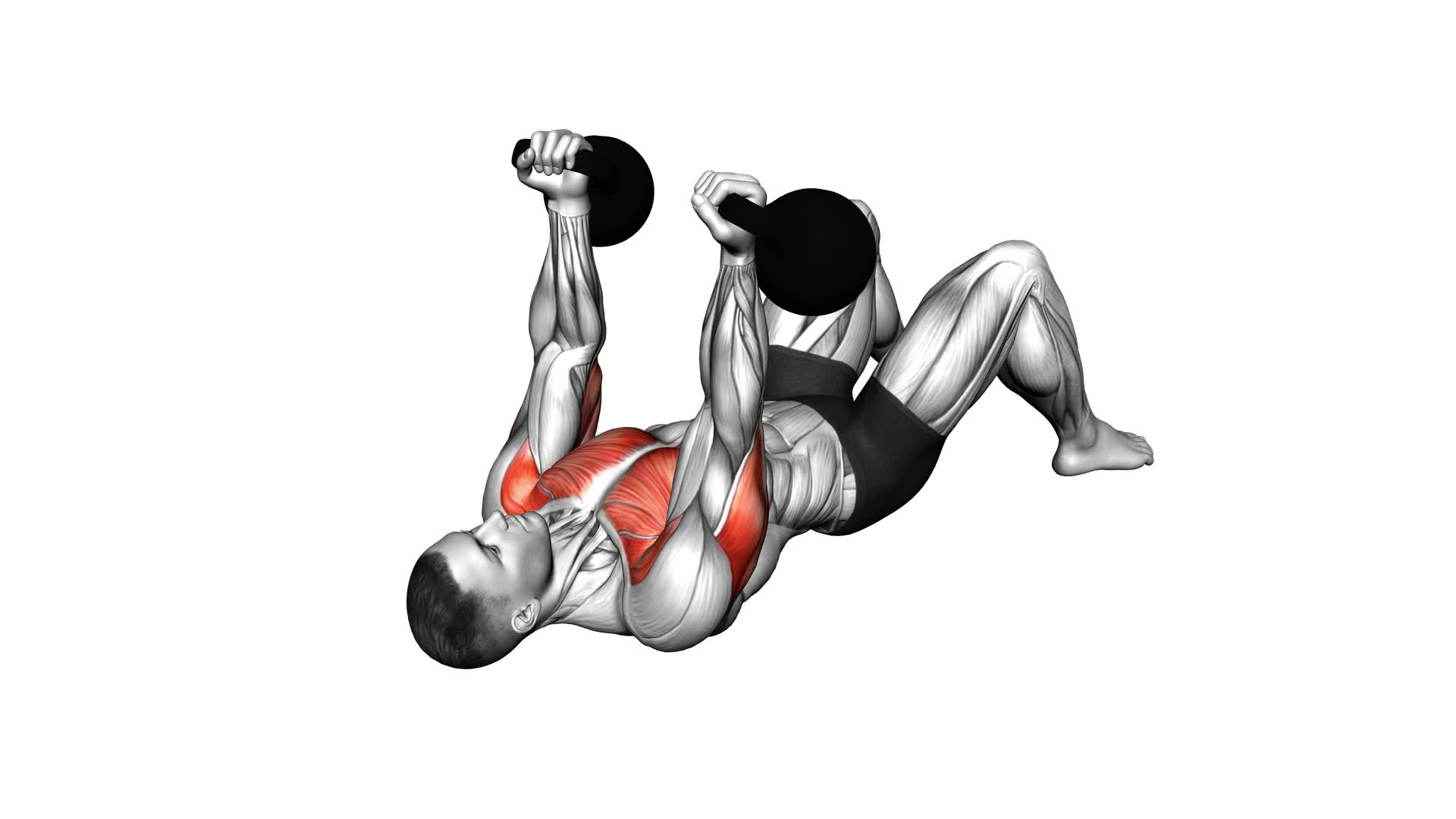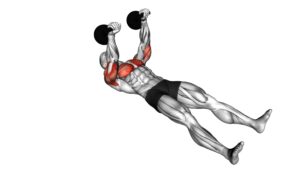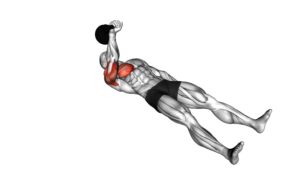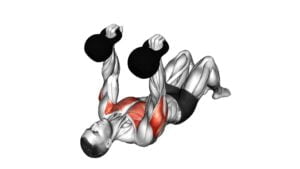Kettlebell Reverse Press on Floor – Video Exercise Guide & Tips

Looking to strengthen your upper body and core? The kettlebell reverse press on the floor is a great exercise to add to your routine.
Watch This Exercise Video
In this video exercise guide, we'll show you the proper form and technique, as well as common mistakes to avoid.
Plus, we'll provide tips for progression and variation to keep your workouts challenging.
Get ready to take your fitness to the next level with this effective kettlebell exercise.
Let's get started!
Key Takeaways
- The Kettlebell Reverse Press builds strength and muscle while improving stability and core strength.
- It engages multiple muscle groups simultaneously, making it a highly efficient exercise.
- Proper form and technique, such as keeping your back straight and fully extending your arms at the top of the movement, are crucial for performing the Kettlebell Reverse Press correctly.
- Progression and variation, such as varying the grip position and tempo, incorporating other exercises, and gradually increasing the difficulty, can add variety and challenge to your workout routine.
Benefits of the Kettlebell Reverse Press
To maximize your workout, incorporating the kettlebell reverse press offers numerous benefits. This exercise not only helps to build strength and muscle, but it also improves stability and core strength. One of the key benefits of the kettlebell reverse press is its ability to engage multiple muscle groups simultaneously, making it a highly efficient exercise. By using proper form and technique, you can also minimize the risk of injuries.
In order to prevent injuries during the kettlebell reverse press, it's important to focus on proper form and technique. Start with a weight that you can handle comfortably and gradually increase the weight as you become more proficient. It's also important to warm up and stretch before performing this exercise to prepare your muscles and joints.
To progress and vary your kettlebell reverse press workout, you can try different variations of the exercise. For example, you can vary the grip position or the tempo of the movement. You can also incorporate other exercises, such as lunges or squats, to further challenge your muscles and add variety to your workout routine.
Proper Form and Technique
To ensure optimal results and minimize the risk of injury, it's crucial that you maintain proper form and technique while performing the kettlebell reverse press on the floor. Here are some important tips to keep in mind:
- Keep your back straight: It's essential to maintain a neutral spine throughout the exercise. Avoid arching your back or rounding your shoulders, as this can put unnecessary strain on your spine.
- Engage your core: Activate your core muscles by pulling your belly button towards your spine. This will provide stability and support during the movement, helping you maintain balance and control.
- Use controlled movements: Avoid rushing through the exercise and focus on performing each repetition with control. This won't only enhance the effectiveness of the exercise but also reduce the risk of injury.
Common errors to watch out for include using too much weight, which can compromise your form, and not fully extending your arms at the top of the movement. Remember, proper form is essential for getting the most out of this exercise and preventing injuries.
For those looking for advanced variations, you can try performing the kettlebell reverse press on an unstable surface like a Bosu ball or a stability disk. This will challenge your core stability and further engage your muscles. However, it's important to progress gradually and only attempt advanced variations once you have mastered the basic form.
Equipment Needed for the Exercise
To perform the kettlebell reverse press on the floor, you'll need a kettlebell and a comfortable exercise mat. These are the necessary equipment for this exercise. The kettlebell should have a weight that challenges you but still allows for proper form and technique. It's recommended to start with a lighter weight and gradually increase as you become more comfortable with the exercise.
When choosing an exercise mat, opt for one that provides enough cushioning and support to protect your joints and prevent injuries. A thicker mat is generally better for this exercise, as it can help absorb impact and reduce strain on your wrists and elbows.
Safety precautions should be taken when performing the kettlebell reverse press on the floor. Ensure that the area around you is clear of any obstacles or hazards that could cause you to trip or lose balance. It's also important to maintain proper form throughout the exercise to avoid strain or injury. If you have any existing medical conditions or concerns, it's advisable to consult with a healthcare professional before attempting this exercise.
Remember to always prioritize safety and listen to your body. Start with lighter weights and gradually increase as you build strength and confidence. By using the necessary equipment and taking precautions, you can perform the kettlebell reverse press on the floor safely and effectively.
Step-by-Step Video Guide
Now, let's go through the step-by-step video guide for the kettlebell reverse press on the floor exercise.
This guide will provide you with the proper form tips to ensure you perform the exercise correctly and avoid common mistakes.
Additionally, we'll discuss the benefits of incorporating this exercise into your workout routine.
Proper Form Tips
Follow these proper form tips to perform the Kettlebell Reverse Press on the floor correctly:
- Maintain a neutral spine: Avoid rounding your back or arching excessively to prevent strain on your lower back.
- Engage your core: Keep your abdominal muscles tight throughout the exercise to provide stability and protect your spine.
- Use proper breathing technique: Inhale as you lower the kettlebell and exhale as you press it up, coordinating your breath with the movement.
By following these tips, you can ensure proper form and maximize the effectiveness of the Kettlebell Reverse Press while minimizing the risk of injury.
Now let's move on to the next section to learn about common mistakes to avoid.
Common Mistakes to Avoid
To avoid common mistakes, ensure proper technique while performing the Kettlebell Reverse Press on the floor. There are a few common misconceptions that can hinder your progress with this exercise.
One of them is using too heavy of a kettlebell. It's important to start with a weight that challenges you but still allows you to maintain proper form throughout the movement.
Another mistake to avoid is arching your back or rounding your shoulders. Keep your core engaged and your spine neutral throughout the exercise.
Additionally, make sure to modify the exercise according to your fitness level. If you're a beginner, start with a lighter kettlebell or even just bodyweight to build strength and stability before advancing.
Now that we've discussed these common mistakes, let's move on to the benefits of this exercise.
Benefits of This Exercise
To maximize the effectiveness of the Kettlebell Reverse Press on the floor, it's essential to understand the benefits of this exercise. Here are the key benefits:
- Increased upper body strength: The Kettlebell Reverse Press targets the muscles in your chest, shoulders, and triceps, helping to build strength and definition in these areas.
- Improved core stability: By performing the exercise on the floor, you engage your core muscles to stabilize your body throughout the movement. This helps to improve your overall balance and stability.
- Enhances shoulder mobility: The Kettlebell Reverse Press requires a full range of motion in your shoulders, helping to improve flexibility and mobility in this area.
Variations of the Kettlebell Reverse Press can further enhance the benefits of this exercise. By using different kettlebell weights or changing the tempo of the movement, you can challenge your muscles in new ways and continue to make progress. Remember to always maintain proper form and consult a fitness professional if you have any concerns or questions.
Common Mistakes to Avoid
When performing the kettlebell reverse press on the floor, it's crucial for beginners to focus on proper form to avoid injury.
One common mistake to avoid is arching your back, as this can strain your lower back and potentially lead to injury.
Another mistake is using too heavy of a kettlebell, which can compromise your form and increase the risk of injury.
Proper Form for Beginners
Avoid the common mistakes beginners make when performing the Kettlebell Reverse Press on the floor. Proper form is crucial to maximize the benefits of this exercise and prevent injuries. Here are some tips to help you get started:
- Maintain a stable base: Position your feet shoulder-width apart and keep your core engaged throughout the exercise. This will provide stability and prevent any unnecessary strain on your lower back.
- Control the movement: Slowly lower the kettlebell to your shoulder while keeping your arm close to your body. Avoid swinging the weight or using momentum to lift it back up. This will ensure that you're effectively targeting the muscles in your shoulder and upper back.
- Start with lighter weights: As a beginner, it's important to focus on mastering the proper form before increasing the weight. Begin with a lighter kettlebell and gradually progress as you become more comfortable and confident with the exercise.
Injury Prevention Techniques
To prevent injuries while performing the Kettlebell Reverse Press on the floor, focus on proper technique and follow these injury prevention techniques.
First, make sure you warm up properly before starting the exercise. This will help prepare your muscles and joints for the workout.
Additionally, it's important to maintain a neutral spine throughout the movement to avoid straining your back. Engage your core muscles and keep your shoulders down and back to maintain stability.
Another key aspect of injury prevention is using the appropriate weight for your strength level. Starting with a lighter kettlebell and gradually increasing the weight will help prevent overexertion and reduce the risk of injury.
Lastly, listen to your body and take breaks when needed. Pushing through pain can lead to injury, so pay attention to any discomfort and adjust accordingly.
Tips for Progression and Variation
For progression and variation, try incorporating different kettlebell weights into your reverse press on the floor routine. This will help you to continuously challenge your muscles and promote progressive overload, which is essential for strength gains.
Here are some tips to help you progress and vary your kettlebell reverse press on the floor:
- Increase the weight: Start with a lighter kettlebell and gradually work your way up to heavier weights as your strength improves. This will ensure that you're constantly challenging your muscles and making progress.
- Change the grip: Experiment with different grip variations, such as a neutral grip or pronated grip, to target different muscles and add variety to your workout. This can help prevent plateaus and keep your workouts interesting.
- Alter the tempo: Vary the speed at which you perform the reverse press on the floor. Slow down the lowering phase to increase time under tension and focus on muscle contraction, or speed up the movement to add an explosive element to your workout.
Frequently Asked Questions
How Does the Kettlebell Reverse Press Compare to Other Upper Body Exercises in Terms of Muscle Activation?
When comparing the kettlebell reverse press to other upper body exercises in terms of muscle activation, it's important to consider the specific muscles targeted.
The reverse press primarily activates the shoulders, triceps, and chest, making it a great exercise for overall upper body strength.
Additionally, the kettlebell reverse press can be modified to improve shoulder mobility, making it beneficial for those with limited range of motion.
Can the Kettlebell Reverse Press Be Modified for Individuals With Limited Shoulder Mobility?
If you have limited shoulder mobility, don't worry! There are modifications you can make to the kettlebell reverse press. Instead of using a kettlebell, you can try using dumbbells or resistance bands. These alternatives can reduce strain on your shoulders while still targeting your upper body muscles.
Remember to consult with a fitness professional to ensure you're using proper form and technique.
Keep pushing yourself and finding exercises that work for you!
Are There Any Specific Breathing Techniques That Should Be Used During the Kettlebell Reverse Press?
During the kettlebell reverse press, it's important to focus on your breathing techniques. Proper breathing can help you maintain control and stability throughout the exercise.
Take a deep breath in before starting the press, and exhale as you push the kettlebell up. This can help engage your core muscles and provide additional support for your shoulders.
Does the Kettlebell Reverse Press Primarily Target the Chest or the Shoulders?
When performing the Kettlebell Reverse Press, you might wonder if it primarily targets your chest or shoulders.
The muscle activation comparison shows that both muscle groups are engaged, but the shoulders are the main focus.
However, if you have limited shoulder mobility, modifications can be made to emphasize chest activation.
Remember to incorporate proper breathing techniques and ensure full body integration for optimal results.
Can the Kettlebell Reverse Press Be Incorporated Into a Full-Body Workout Routine or Is It Best Performed as a Standalone Exercise?
Incorporating the kettlebell reverse press into your full body workout routine can be a great way to target multiple muscle groups. It helps build strength in your chest, shoulders, and triceps, while also engaging your core and lower body.
If you have limited shoulder mobility, you can modify the exercise by using lighter weights or performing a seated variation.
Remember to always consult with a professional trainer for proper form and technique.
Conclusion
In conclusion, the kettlebell reverse press is a beneficial exercise that targets the shoulders, triceps, and core muscles. By following proper form and technique, using the necessary equipment, and avoiding common mistakes, you can effectively perform this exercise.
Additionally, incorporating progression and variation will help you continue to challenge your muscles and see progress in your fitness journey. Stay consistent and focused, and you'll reap the rewards of this exercise.

Author
Years ago, the spark of my life’s passion ignited in my mind the moment I stepped into the local gym for the first time. The inaugural bead of perspiration, the initial endeavor, the very first surge of endorphins, and a sense of pride that washed over me post-workout marked the beginning of my deep-seated interest in strength sports, fitness, and sports nutrition. This very curiosity blossomed rapidly into a profound fascination, propelling me to earn a Master’s degree in Physical Education from the Academy of Physical Education in Krakow, followed by a Sports Manager diploma from the Jagiellonian University. My journey of growth led me to gain more specialized qualifications, such as being a certified personal trainer with a focus on sports dietetics, a lifeguard, and an instructor for wellness and corrective gymnastics. Theoretical knowledge paired seamlessly with practical experience, reinforcing my belief that the transformation of individuals under my guidance was also a reflection of my personal growth. This belief holds true even today. Each day, I strive to push the boundaries and explore new realms. These realms gently elevate me to greater heights. The unique combination of passion for my field and the continuous quest for growth fuels my drive to break new ground.







